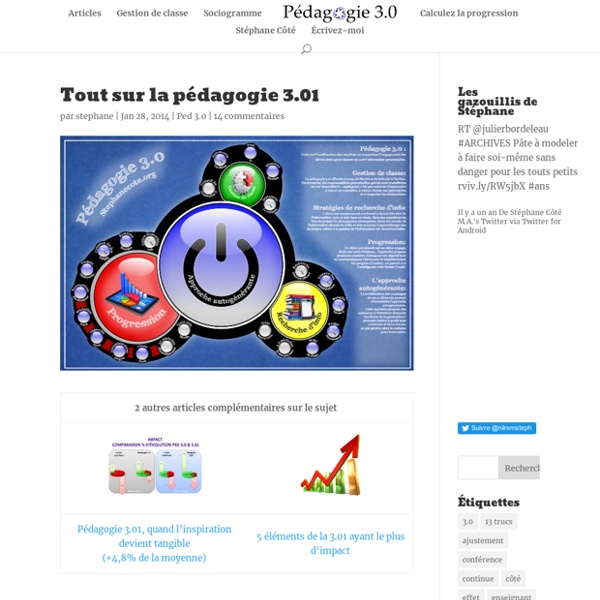



http://www.stephanecote.org/2014/01/28/tout-sur-la-pedagogie-3-0/
Related: Pédagogie numérique • TraAM • E learning • Outils pour la classeIntroducing Design Thinking to Elementary Learners Design thinking is an approach to learning that includes considering real-world problems, research, analysis, conceiving original ideas, lots of experimentation, and sometimes building things by hand. The projects teach students how to make a stable product, use tools, think about the needs of another, solve challenges, overcome setbacks and stay motivated on a long-term problem. The projects also teach students to build on the ideas of others, vet sources, generate questions, deeply analyze topics, and think creatively and analytically.
The Flipped Classroom Guide for Teachers As technology becomes increasingly common in instruction at all levels of education from kindergarten to college, the modern classroom is changing. The traditional teacher-centered classroom is falling away to give students a student-centered classroom where collaborative learning is stressed. One way educators are effectively utilizing online learning and changing the way they teach is by flipping their classrooms. What is a Flipped Classroom? High school teachers Aaron Sanns and Jonathan Bergman were the first to flip their classrooms.
ePedagogy Introduction Despite an increased interest in the use of e-learning to enhance students’ learning, it is surprising that so little research has been conducted to justify these claims. Goodyear (2001GoodyearP (2001) Psychological foundations of networked learningin: C. Jones & C. Smart Working: Mastering the Skill of Effective Mind Mapping This course will teach you how to use mind maps to increase your personal and professional productivity. You’ll learn how to save time on any task that requires planning, preparation, and clarity. You will be taught how to develop and use this powerful productivity tool in a unique and effective way. 5 tools to leverage augmented reality - Page 2 of 2 - eCampus News The University of Maryland also is home to the Virtual and Augmented Reality Laboratory, also known as the Augmentarium. The Augmentarium’s main technology is the highly popular Oculus Rift. Augmented reality’s applications within learning could be limitless, because any concept with a special or physical component can be better understood through a student’s firsthand use of the technology, and would likely make learning even more interesting and exciting for most students, university representatives said. Cogswell Polytechnical College has launched a new virtual reality and augmented reality certificate program, which addresses the development of content for both technologies.
These Are The Reasons Why Learners Forget Your Training "Training doesn’t help one jot if people can’t remember it in the real world" —Teresa Ewington Our biggest goal in training is to get students to remember the material. In order to do this more effectively, it helps to understand exactly what causes the mind to forget things. By understanding what makes a person forget, we can incorporate things into our programs that help counteract those causes. Forgetting is an important function. It helps a human filter out trivial things that would clog the brain and override important information.
6 Expert Tips for Flipping the Classroom Tech-Enabled Learning | Feature 6 Expert Tips for Flipping the Classroom Three leaders in flipped classroom instruction share their best practices for creating a classroom experience guaranteed to inspire lifelong learning. Bloom, Kolb s.a 1. Introduction Information and Communication Technology (ICT) applications, in particular with the education system, might change the future of the underdeveloped world, eliminating the digital divide from the education system both locally and in the international arena [1]. However, there are some challenges that the developing world faces in trying to adopt ICT to the education sector. Introducing “An Educator’s Guide to Sketchnoting” Whenever I tell my teacher friends about my experiments here with visual note taking, most get excited for me, many end up trying out sketchnoting for themselves, and a number of them also ask about how to incorporate this skill into the classroom. To help teachers expose their students to the idea of sketchnoting, I have decided to write a guide that provides an overview of sketchnoting, explains how it can be used as a powerful learning tool, and provide suggestions for how to incorporate the teaching of this skill into classroom activities. When children first learn to write, the idea of combining words and pictures comes naturally.